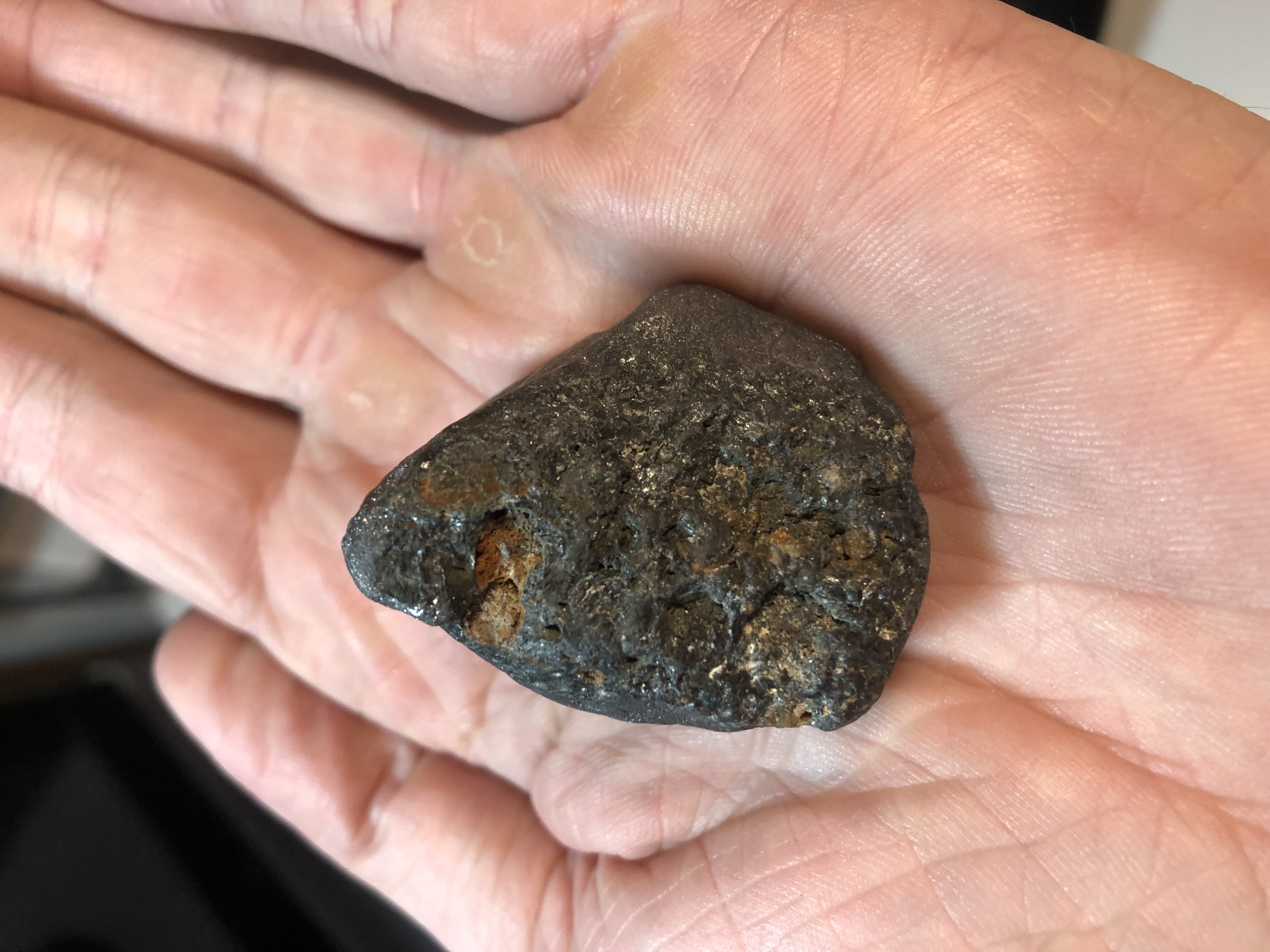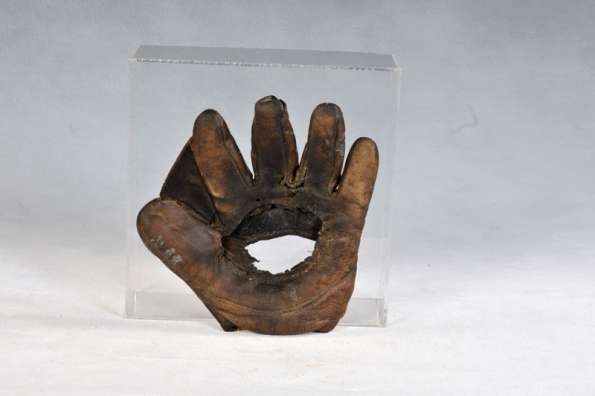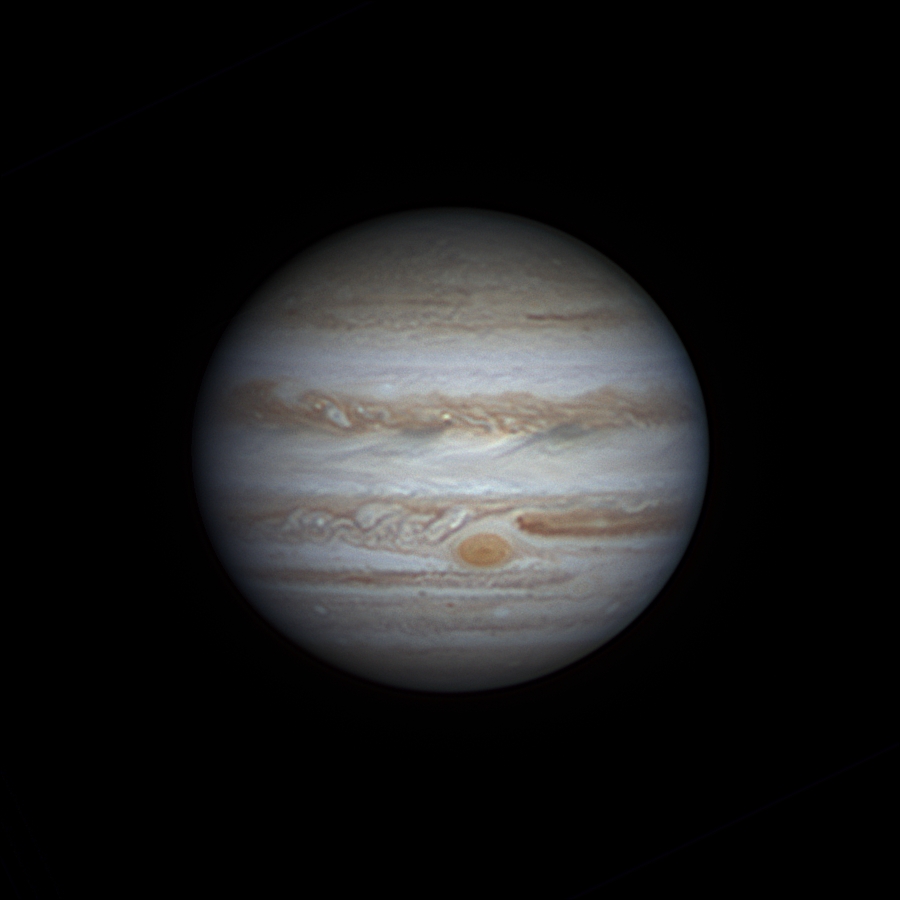realrockhound
Cave Dweller  Chucking leaverite at tweekers
Chucking leaverite at tweekers
Member since June 2020
Posts: 4,483
|
Post by realrockhound on Oct 21, 2023 23:17:35 GMT -5
What is this? Weighs 4.31 oz   |
|
|
|
Post by hummingbirdstones on Oct 21, 2023 23:58:31 GMT -5
Looks like some type of pyrite possibly.
|
|
|
|
Post by vegasjames on Oct 22, 2023 0:44:10 GMT -5
Looks like slag to me.
|
|
|
|
Post by jasoninsd on Oct 22, 2023 1:14:59 GMT -5
I think it's a meteorite!
|
|
michiganpebbler
spending too much on rocks
 
Member since April 2023
Posts: 344 
|
Post by michiganpebbler on Oct 22, 2023 10:23:56 GMT -5
I think it's a meteorite!  |
|
|
|
Post by jasoninsd on Oct 22, 2023 10:52:06 GMT -5
I think it's a meteorite!  Is that supposed to be Chicken Little?!? LOL  |
|
|
|
Post by Starguy on Oct 25, 2023 16:47:55 GMT -5
Chromite tends to be slightly magnetic. If it swings a compass needle, that may be it.
|
|
|
|
Post by rmf on Oct 25, 2023 18:31:10 GMT -5
This looks like a sulfide ore like massive galena. What is the hardness? What color is the streak? Gray possibly galena, black magnetite, red hematite though it does not appear to be hematite. Is it magnetic?
|
|
Fossilman
Cave Dweller 
Member since January 2009
Posts: 20,722 
|
Post by Fossilman on Nov 2, 2023 12:14:28 GMT -5
If you think it's a meteorite, have it tested at a local University...
Doesn't look like it to me though..
|
|
jamesp
Cave Dweller 
Member since October 2012
Posts: 36,602
|
Post by jamesp on Nov 20, 2023 7:42:16 GMT -5
Never try to catch a meteorite.  |
|
|
|
Post by vegasjames on Nov 20, 2023 7:48:30 GMT -5
If you think it's a meteorite, have it tested at a local University... Doesn't look like it to me though.. Meteorites do not have bubbles like that and would have a smoother surface. If it were not for the bubbles, I would say magnetite. With the bubbles though, more likely slag. |
|
jamesp
Cave Dweller 
Member since October 2012
Posts: 36,602
|
Post by jamesp on Nov 20, 2023 8:43:53 GMT -5
That meteorite shattered ice that impacted the elliptical shaped and radially oriented Carolina Bays likely had bubbles in it James  . |
|
|
|
Post by vegasjames on Nov 20, 2023 14:44:42 GMT -5
That meteorite shattered ice that impacted the elliptical shaped and radially oriented Carolina Bays likely had bubbles in it James  . "Likely" does not mean did. And ice is not the same as meteorites.
They are still debating on the how the Carolina Bays formed. There is no solid evidence yet of a meteorite impact leading to the formation yet, just a hypothesis. Where are the meteorite fragments? High nickel levels?
An easy way to determine if this is a meteorite, slag or magnetite is to simply do a specific gravity test. There is a big difference in the specific gravity between iron meteorites and terrestrial iron ores or slag.
|
|
jamesp
Cave Dweller 
Member since October 2012
Posts: 36,602
|
Post by jamesp on Nov 21, 2023 9:35:48 GMT -5
That meteorite shattered ice that impacted the elliptical shaped and radially oriented Carolina Bays likely had bubbles in it James  . "Likely" does not mean did. And ice is not the same as meteorites.
They are still debating on the how the Carolina Bays formed. There is no solid evidence yet of a meteorite impact leading to the formation yet, just a hypothesis. Where are the meteorite fragments? High nickel levels?
An easy way to determine if this is a meteorite, slag or magnetite is to simply do a specific gravity test. There is a big difference in the specific gravity between iron meteorites and terrestrial iron ores or slag.
 The truth will just have to remain a mystery. As Pilate said, "What is truth" ? |
|
realrockhound
Cave Dweller  Chucking leaverite at tweekers
Chucking leaverite at tweekers
Member since June 2020
Posts: 4,483
|
Post by realrockhound on Nov 26, 2023 15:25:08 GMT -5
Since I’ve been MIA in this thread. Lil backstory. My grandpa was the one who found this. My dad was with him when he did. I know the general location it was found. I am by no means saying it is a meteorite. Two big reasons why I posted it here is to get an idea. First being location of where it was found. Odd location as it’s very unlikely it’s man made slag (could be natural formation)?. Second is that my grandpa had taken it to the local college to get an identification. They believed it was a meteorite and wanted to hang onto it to run tests. My dad said my grandpa figured he’d never see it again and decided he didn’t want to risk leaving it with them. So never had the tests ran. Since I went to Oregon state university, I’m going to try to line out a time I can take it over there, and have them do the tests with me present. Hopefully get an answer on what it is.
|
|
|
|
Post by vegasjames on Nov 26, 2023 18:54:30 GMT -5
Since I’ve been MIA in this thread. Lil backstory. My grandpa was the one who found this. My dad was with him when he did. I know the general location it was found. I am by no means saying it is a meteorite. Two big reasons why I posted it here is to get an idea. First being location of where it was found. Odd location as it’s very unlikely it’s man made slag (could be natural formation)?. Second is that my grandpa had taken it to the local college to get an identification. They believed it was a meteorite and wanted to hang onto it to run tests. My dad said my grandpa figured he’d never see it again and decided he didn’t want to risk leaving it with them. So never had the tests ran. Since I went to Oregon state university, I’m going to try to line out a time I can take it over there, and have them do the tests with me present. Hopefully get an answer on what it is. When having a suspected meteorite tested, you do not give them the whole thing. Generally it is 20 grams or if the whole thing is under 100 grams, then 20%. That is payment for the testing. Some labs want 30 grams or 30%. When I sent off samples for my suspected meteorite, I sent them I think it was 48 grams between 2 samples. I sent 2 because as I explained to them, they do not look alike, but if they examine them under the microscope they will find they are the same stone. One sample was gray with smaller inclusions mainly of plagioclase, and the other dark with larger plagioclase inclusions as well as olivine and what appears to be a zeolite. Both have fragments of iron-nickel, which is super rare in terrestrial rocks. Since slower cooling times result in larger crystal formation, my guess is that the darker material was more impact melted resulting in a longer cooling time allowing for the increased crystal growth. Anyway, so the sample has to be cut regardless if going to sent for testing. And seeing the inside can also tell you right away if it is a meteorite as the interior would be bright, shiny silver, not dark metal. Although slag can also be bright shiny silver on the inside, if dark that would definitely rule out an iron meteorite. A streak test can also help rule out magnetite or hematite as both leave colored streaks as where a true iron meteorite will not. This brings up another point as to why I am certain this is not a meteorite. When doing a streak test, it is important to get down to the clean metal as iron meteorites will form a thin coat of rust, and sometimes rust through, with exposure to the elements. I found one in the wall of a wash one time, but unfortunately it had rusted through due to all the water and being exposed to air. How resistant an iron meteorite will be to rusting through depends on its nickel content. Still, exposure will lead to at least a thin layer of rust on the surface of real iron meteorites unless it is collected right away. And again, the bubbles are a dead giveaway that this is not a meteorite. The top is somewhat smooth, but the bottom is too rough. Meteors hit the atmosphere at 10,000 to 30,000 miles per hour causing intense frictional heating sufficient to form the bolide (gas plasma) that allows us to see them. This frictional heating also melts the surface, with any rough areas being ablated away due to even higher friction. Therefore, if this were a meteorite, that rough surface on the bottom would not exist. It would have been ablated away. The only rough surfaces we see on meteorites are the edges formed from the break up of stony meteorites or the shrapnel of iron meteorites that break up so low in the atmosphere that they do not have time to re-melt. Still they do not have bubbles, and that rough surface would have been melted if this was a meteorite. I suggest starting with the streak test to see if it is a iron ore. |
|
realrockhound
Cave Dweller  Chucking leaverite at tweekers
Chucking leaverite at tweekers
Member since June 2020
Posts: 4,483
|
Post by realrockhound on Nov 26, 2023 19:55:29 GMT -5
I’ll do a couple tests here and see if I can’t start narrowing down what it is. I’m just more or less curious what it is as this point and why it was where it was. It very well could be slag someone threw out there. Just odd someone would go out in the middle of the Maury’s up in the trees and throw it out. Unless an Indian was packing it then threw it out for whatever reason.
|
|
realrockhound
Cave Dweller  Chucking leaverite at tweekers
Chucking leaverite at tweekers
Member since June 2020
Posts: 4,483
|
Post by realrockhound on Dec 27, 2023 21:10:04 GMT -5
Nope. My dad has it now and I haven’t been over there to do anything with it since.
|
|
wargrafix
Cave Dweller 
Member since June 2023
Posts: 1,085
|
Post by wargrafix on Jan 7, 2024 13:29:59 GMT -5
The hunt continues
|
|
|
|
Post by orrum on Jan 8, 2024 8:11:33 GMT -5
Carolina Bays...The Mother Ship Landings!!!
|
|











 .
.










